Battle of France: Assault on Laon
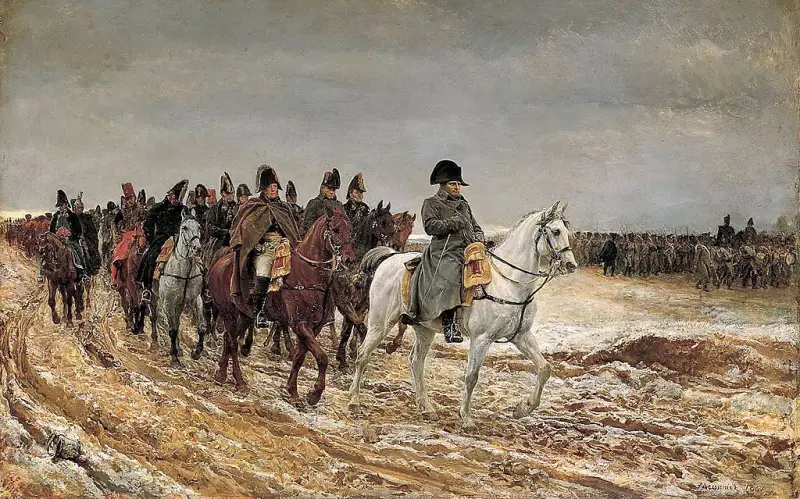
Napoleon returns to Soissons after the Battle of Laon. Following Napoleon are Marshals Ney and Berthier, Generals Drouot and Gerard. French artist Jean-Louis-Ernest Meissonnier
General situation
After the Battle of Craon, in which Napoleon, on March 7, 1814, at the cost of heavy losses, knocked out 2 Russian infantry divisions from the Craon plateau (How two Russian divisions stopped Napoleon's army), Russian troops retreated through Chevrigny to Laon.
Here Prussian Field Marshal Blucher gathered his entire army, 109 thousand soldiers (22 thousand of them cavalry) and 260 guns. They even brought up the garrison of the Soissons fortress, which controlled an important bridge across the river. En. At the same time, Blucher believed that Napoleon had much more forces than he actually had (almost half as much as the allies).
Two roads led to Laon, so the Prussian commander placed the Wintzingerode corps on the right flank on the outskirts of the city on the Soissons road. Laon itself, surrounded by a fortress wall and rampart, was occupied by von Bülow's Prussian corps. And on the left flank, on the way from Berry-au-Bac, the Prussian corps of Kleist and York were located. The Lanzheron and Osten-Sacken formations remained in reserve.
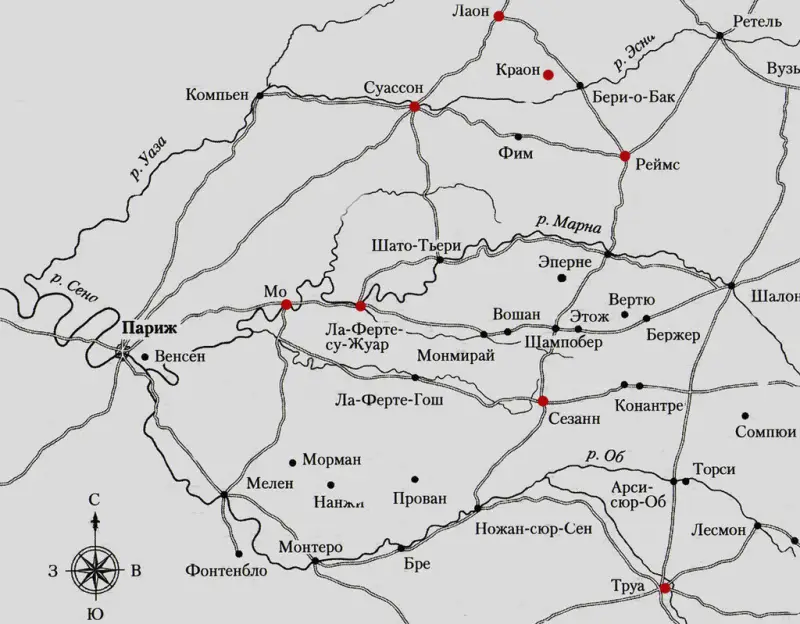
The French emperor pulled together all possible forces, increasing the size of the army to 52 thousand soldiers (including 10 thousand cavalry) with 180 guns. Bonaparte, unlike his allies, underestimated the enemy. He believed that in front of him was only part of the enemy army, its rearguards.
In addition, his army was divided into two parts: the emperor himself walked along the road from Soissons, Marshal Marmont with an 11-thousandth corps - from Reims. The two parts of the French army were separated by swampy terrain, and Cossack patrols also scurried around here, intercepting envoys. Therefore, the French had problems with communication.
The city of Laon (Lahn) itself was the ancient capital of France with a strong medieval fortress surrounded by a rampart. The city was located on a high hill. There were towers with loopholes and an old fortress wall. That is, the defenders had a dominant position over the terrain.
There were suburbs and villages around the city, small rivers and rough terrain narrowed the possibilities for using cavalry.
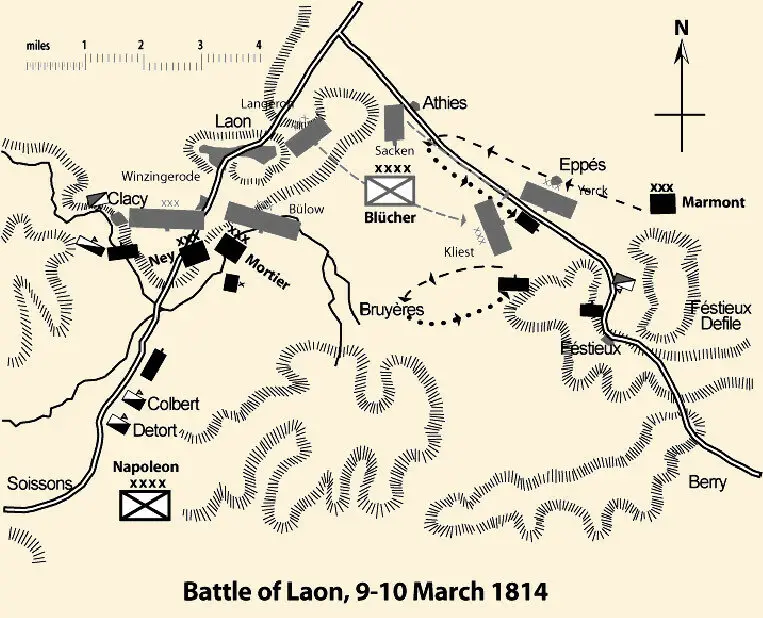
Assault
On March 9, 1814, Napoleon stood in front of Laon, where not the rearguard, but the entire army of Blucher was waiting for him, and even in an excellent position. Most of the allied army was located north and east of the city, behind the heights that hid them from the French.
In the morning, under the cover of thick fog, Marshal Ney with two divisions of the Young Guard stormed the suburb of Semilles at the foot of the Laon Hill, and Marshal Mortier with the attached cavalry occupied the village of Ardon, east of Semilles.
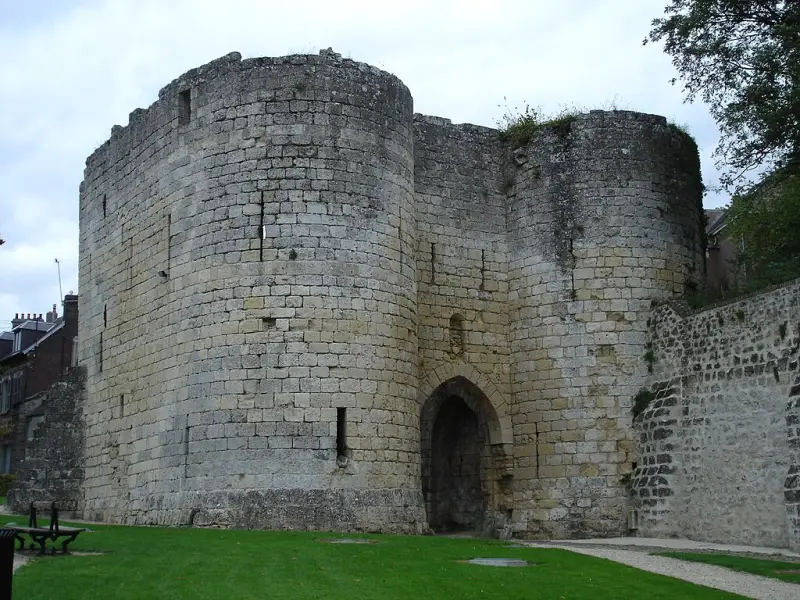
Soissons Gate. Laon
Russian and Prussian troops under the command of Bülow and Vorontsov launched a counterattack and recaptured the positions. A fierce battle broke out. During the day, positions changed hands four times. Ultimately, Ney's guards held Semillae, and the allies recaptured Ardon. At about 4 o'clock in the afternoon, Charpentier's division captured the village of Classy, and Marshal Marmont, with the help of Arrighi's division, took the village of Aties on the enemy's left flank.
Night stopped the battle. As a result, the French captured forward positions, but were unable to advance further up the Laon Hill. Napoleon, due to the loss of his messengers, did not know what was happening at the Marmont front.
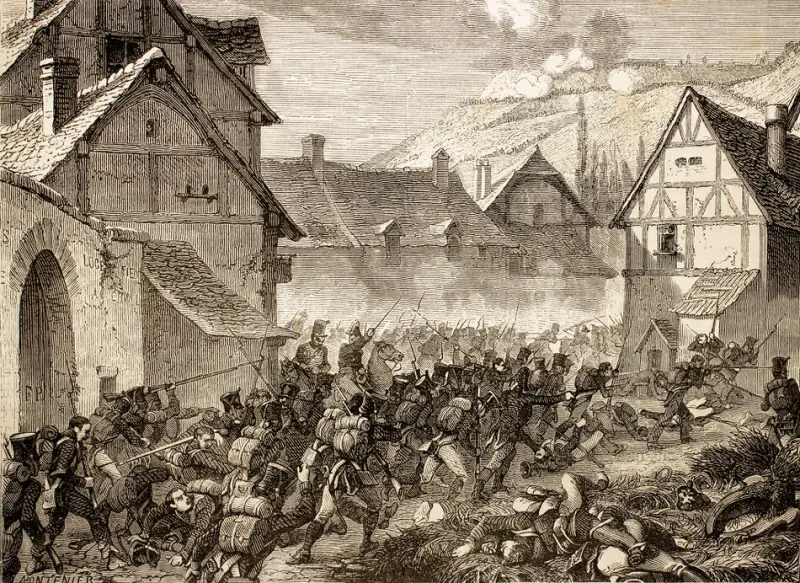
Battle of Laon: Marshal Ney captures the suburb of Semille. Illustration for the book by Adolphe Thiers "History Consulates and empires"
Defeat of Marmont
On the night of March 9-10, the Prussian infantry of generals York and Kleist, with the support of Ziethen's cavalry and the entire horse artillery of the army, was able to deliver a surprise attack on Marmont's corps, which was resting. The French were unable to repel the blow and fled in disarray to the Festier Gorge. Marmont lost more than 3 thousand people (including 2 thousand prisoners) and all the artillery - 45 guns.
Despite the defeat of Marmont's corps, the French continued their attacks on Laon on the morning of March 10. Attack followed attack, Ney's soldiers reached the old fortress wall. However, the Allies repulsed this assault as well. Napoleon did not have enough soldiers, and after 4 o'clock in the afternoon he began to withdraw troops beyond the Aisne. The Allies did not pursue the enemy.
The French were helped by the attack of illness of the Prussian commander. After the defeat of 1806–1807. Blucher's health was undermined. The difficulties of the campaign and the unprecedented strain of strength of the last two months obviously affected the health of the 72-year-old field marshal. He was in such poor condition that he could not lead the troops or respond to requests from staff officers.
The leadership of the army passed to the chief of staff Gneisenau, who was not distinguished by decisiveness and authority among the commanders. The chief of staff gave the order to return back to Laon to the troops who were pursuing Marmont, and to the corps of Langeron and Osten-Sacken, who were given the task of reaching the rear of the French army through Brewer, cutting it off from Soissons.
Napoleon gave the order for a night retreat to Soissons and calmly left. The remnants of Marmon's corps also went to Fim. The French lost 9 thousand people in two days of fighting, the allies - up to 4 thousand people.
Thus, the Silesian army, having a complete advantage in strength, missed the chance to encircle and completely defeat Bonaparte and end the war.
Disputes began. General York, angry that the success of his corps was not developed and the defeat of Marshal Marmont was not completed, submitted a petition for dismissal from his post. He was personally persuaded to stay by Blucher and the Prussian Prince Wilhelm.
Russian generals also expressed dissatisfaction with the indecisiveness and caution of the new command.
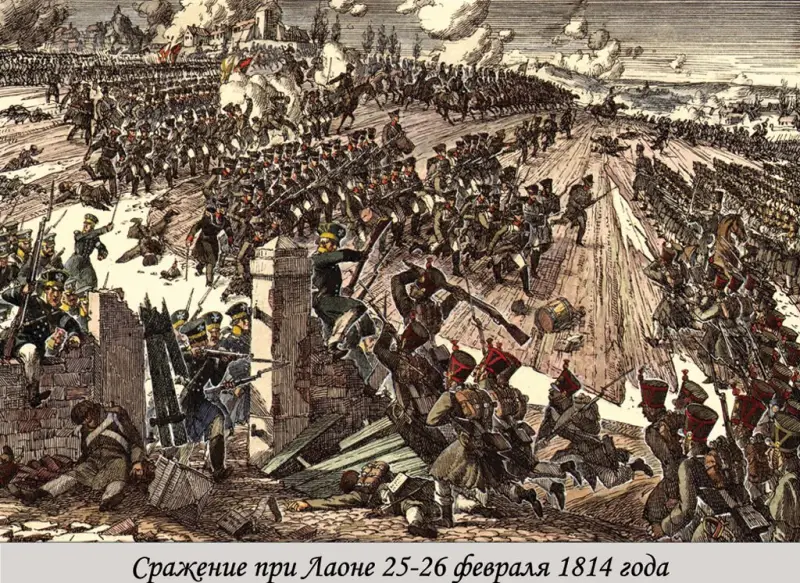
Battle of Laon. Hood. Oleg Parkhaev
Napoleon's revenge at Reims
The French rested in Soissons and received reinforcements arriving from Paris. On March 12, Napoleon learned that the city of Saint-Prix had fallen, which was taken by a Russian-Prussian corps under the command of the Russian general Count E. Saint-Prix (a Frenchman in Russian service). The number of the detachment was 13–14 thousand soldiers, the Russian 8th Infantry Corps and the Prussian division of General Jagow (4 thousand). The French lost several hundred prisoners and up to 10 guns.
Reims was an important point through which it was possible to disrupt the connection between the armies of Blucher and Schwarzenberg and the supply of the Silesian army. Therefore, Napoleon decided to recapture the city.
On March 12, he moved with an army of 30 to Reims. The French again marched in two columns: the main forces from Soissons, Marmont from Berry-au-Bac.
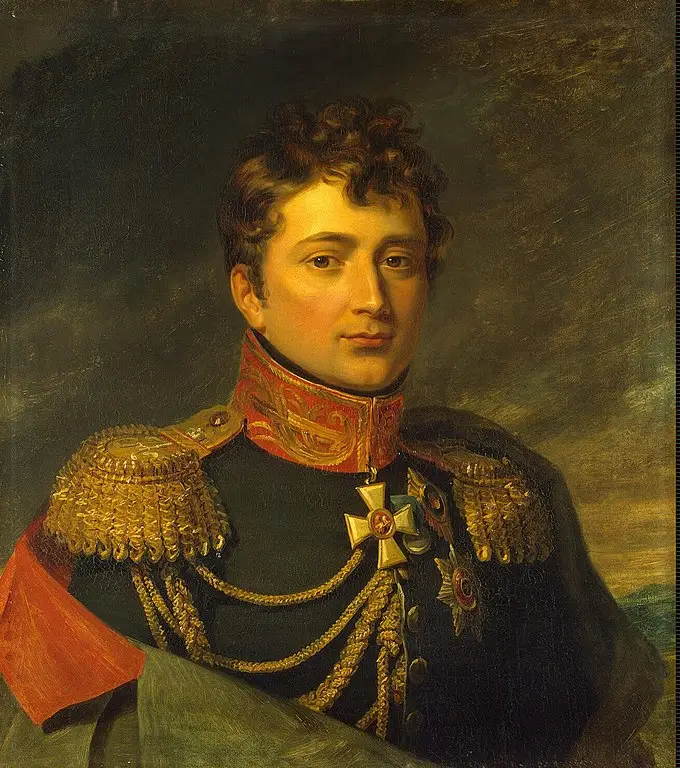
Portrait of Emmanuel Frantsevich Saint-Prix, workshop of George Dow. Military gallery of the Winter Palace,
General Saint-Prix knew that the French army had been defeated at Laon and had retreated to Soissons. He was sure that the enemy was defeated and was not in danger. Troops were stationed in the city and in the suburbs.
On the morning of March 13, 1814, Marmont's vanguards attacked several Prussian battalions and scattered them. Two battalions were blocked in the village of Rosne and folded weapon. Saint-Prix began to gather troops, not yet knowing that the main forces of the enemy were in front of him.
At 4 o'clock in the afternoon a general attack began on the columns of Napoleon and Marmont. The Russian regiments met the blow of superior enemy forces. At the very beginning of this battle, the corps commander was seriously wounded by a cannonball in the shoulder or leg. Data about the circumstances of his injury vary: some sources report that doctors were forced to amputate his wounded leg, others say that part of the bone of his right shoulder, and most of his chest was also crushed by the cannonball. The general was captured and died on March 29.
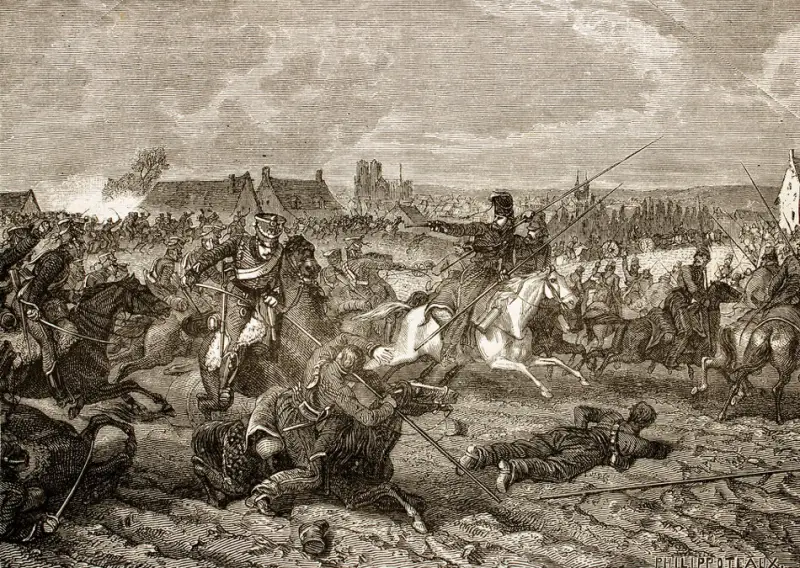
Honor Guard at the Battle of Reims. Hood. Felix Emmanuel Henri Philippoteau. Illustration for the book “History of the Consulate and Empire” by Adolphe Thiers
The troops were commanded by generals I. D. Panchulidzev and G. A. Emmanuel (Manoilovich).
The Ryazan Infantry Regiment under the command of Colonel Ivan Skobelev (grandfather of the famous “White General” M.D. Skobelev) showed particular heroism. While the third battalion of the Ryazan regiment defended the parapet opposite the main gate of Reims and repelled the attacks of the French trying to break into the city, its first battalion, initially located two kilometers from the city walls, formed a square against the French cavalry and, placing the wounded General Saint-Prix in the center , made his way to the third battalion.
Then these two battalions of the Ryazan Infantry Regiment, becoming the core of the Russian rearguard, held back the onslaught of the French until most of the 8th Corps retreated from the city. The Ryazan regiment itself was cut off, but on the night of March 14 it escaped from the enemy through the city back streets.
In the battle near Reims, the Allies lost up to 3,5 thousand people, of which 2,5 thousand were prisoners (almost all Prussians). The French captured 10 or 11 guns, one of them Russian, the rest Prussian. French losses were only about 700.
Napoleon again raised the morale of his army and intercepted important enemy communications.
The Allied command again fell into a stupor, stopped the offensive and gave the initiative to the French.
After giving the army a two-day rest, Bonaparte led the army south against Schwarzenberg's Main Army. On March 17, Napoleon sent his thinned regiments through Fère-Champenoise to Troyes to attack Schwarzenberg's flank or rear.
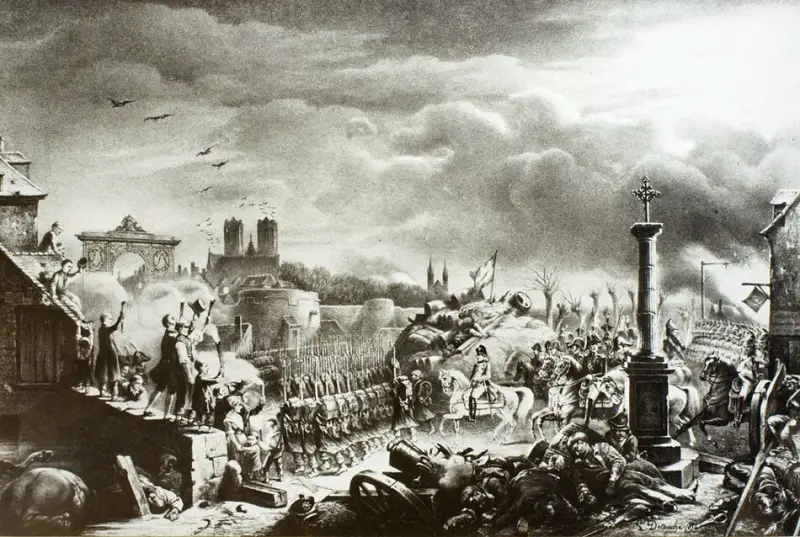
Napoleon's victory at Reims 13 March 1814
Information